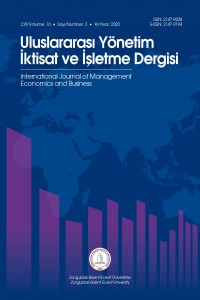EĞİTİM ALTYAPI PROJESİ RATEM’İN KARİYER GELECEĞİ AÇISINDAN ETKİLİLİĞİ: İLETİŞİM ÖĞRENCİLERİ İLE DENEYSEL BİR ARAŞTIRMA
Abstract
İnsanlık tarihinde yeni bir teknolojik devrime tanık olduğumuz bugünler, daha önce
deneyimlenmemiş derin bir değişimi refere etmektedir. Bu bağlamda yükseköğrenimdeki bireylerin mesleki
bilgilerini artırmaya yönelik eğitim altyapı yatırımları, bir yandan işgücü piyasasının niteliğini artırmayı
amaçlarken diğer yandan da bireylerin kariyer gelecekleri açısından katkı sağlamayı hedeflemektedir.
Bu araştırmanın amacı, eğitim altyapı projesi olan RATEM’in, öğrencilerin kariyer gelecekleri açısından
etkililiğinin tespitini içermektedir. Proje kapsamında uygulamalara katılan öğrencilerin oluşturduğu
uygulama grubu kariyer gelecekleri ile ilgili uyumluluk, iyimserlik ve bilgi düzeyleri çerçevesinde kontrol
grubu ile karşılaştırılmıştır. Ölçümlemede, her iki gruba da “Kariyer Geleceği Ölçeği” uygulanmıştır.
Araştırma sonucunda, uygulama grubu öğrencilerinin, kariyer iyimserliği faktörü açısından kontrol grubu
öğrencilerine göre daha yüksek düzeyde olduğu; kariyer geleceği ve iş piyasası bilgisi açısından sorular
bazında farklılıklar görülmesine rağmen faktörler bazında istatistiki manada anlamlı bir farklılığın
oluşmadığı bulgularına ulaşılmıştır.
References
- Arnold, J. (2011). 21st century career concepts: Magic, measurement, and career capital. The Psychologist, 24(2), 106-109.
- Arthur, M., & Rousseau, D. (1996). The boundaryless career. New York: Oxford University Press.
- Arthur, M. (1994). The boundaryless career: A new perspective for organizational inquiry. Journal of Organizational Behavior, 15(4), 295-306.
- Barnett, R. B., & Bradley, L. (2007). The impact of organizational support for career development on career satisfaction. Career Development International, 12(7), 617-636.
- Bayraktaroğlu, S. (2008). İnsan kaynakları yönetimi. Adapazarı: Sakarya Yayınları.
- Becker, G. S. (1993). Human capital: A theoretical and empirical analysis. 3th Edition, Chicago: University of Chicago Press.
- Bosley, S., & Cohen, L. (2009). How other people shape our careers: A typology drawn from career narratives. Human Relations, 62 (10), 1487-1520.
- Creed, P. A., Patton, W., & Bartrum, D. (2002). Multidimensional properties of the LOT-R: Effects of optimism and pessimism on career and well-being related variables in adolescents. Journal of Career Assessment, 10 (1), 42-61.
- Çiftçi, B. (2007). Kariyer planlama. İçinde U. Dolgun (ed.), İnsan kaynakları yönetimi (s.139-166), Bursa: Ekin Kitabevi.
- Erdoğan, İ. (2007). Pozitivist metodoloji-bilimsel araştırma tasarımı, istatistiksel yöntemler, analiz ve yorum. 2. Baskı, Ankara: Erk yayınları.
- Hackett, G., & Byars, A. M. (1996). Social cogntive theory and the career development of African American women. The Career Development Quarterly, 44(4), 322-340.
- Hall, T. D. (1996). Protean careers of the 21st century. Academy of Management Perspectives, 10(4), 8-16.
- Kalafat, T. (2012). Kariyer geleceği ölçeği (KARGEL): Türk örneklemi için psikometrik özelliklerinin incelenmesi. Türk Psikolojik Danışma ve Rehberlik Dergisi, 4(38), 169-179.
- Kidd, M. J., Hirsh, W., & Jackson, C. (2004). Straight talking: The nature of effective career discussion at work. Journal of Career Development, 30 (4), 231-245.
- Kleinberg, J. L. (1976). Adolescent correlates of occupational stability and change. Journal of Vocational Behavior, 9(2), 219-232.
- Kumar, A. (2007). Personal, academic and career development in higher education: SOARing to success. 1 st Edition, London and NY: Routledge.
- Lent, R. W., Brown, S. D., & Hackett, G. (1994). Toward a unifying social cognitive theory of career and academic interest, choice, and performance. Journal of Vocational Behavior, 45(1), 79-122.
- Mikacic, M. T. (2015). The effects of career planning education. Članek, 4(3), 92-109.
- Patton, W., Bartrum, D. A., & Creed, P. A (2004). Gender differences for optimism, self-esteem, expectations and goals in predicting career planning and exploration in adolescents. International Journal for Educational and Vocational Guidance, 4(3), 193-209.
- Polat, F. B., Ardıç, K., & Özdemir, Y. (2016). Bireysel kariyer planlamada etkili olan faktörlerin belirlenmesine yönelik bir araştırma: Sakarya devlet okulları örneği. İşletme Bilimi Dergisi, 4(1), 29-65.
- Ramli, H. S. B., Audrey, L., Li, C., Audrey, C., & Poh, C. (2016). Career success for women in higher education institution: The factors influencing the success of women academician. International Business Management, 10 (17), 3929-3935.
- Rottinghaus, J. P., Day, X. S., & Borgen, F. (2005). The career futures inventory: A measure of careerrelated adaptability and optimism. Journal of Career Assessment, 13(1), 3-24.
- Sahu, S. (2016). Career attitude of employees influencing work engagement: Study of Indian chemical industries. Repositioning, 1(1), 1-10.
- Savickas, M. L. (2002). Career construction: A developmental theory of vocational behavior. In D. Brown (ed.), Career choice and development. 4th ed., (pp. 149-205). San Francisco: Jossey-Bass.
- Savickas, M. L. (2005). The theory and practice of career construction. In S. Brown, R. Lent (Eds.),Career development and counseling: Putting theory and research to work (pp. 42-70). New York: John Wiley.
- Seibert, S. E., & Kraimer, M. L. (2001). The five-factor model of personality and career success. Journal of Vocational Behavior, 58, 1–21.
- Soysal, A. (2006). Kariyer yönetiminde yeni strateji arayışları- Türkiye ölçeğinde bir değerlendirme. Çimento İşveren Dergisi, 5(20), 1-25.
- Super, D. E. (1963). Vocational development in adolescence and early adulthood: Tasks and behaviors. In D. E. Super, R., Starishevsky, N. Matlin, J.P. Jordaan (Eds.), Career development: Self-concept theory (pp. 79-95). New York: College Entrance Examination Board.
Details
| Primary Language | Turkish |
|---|---|
| Journal Section | Research Articles |
| Authors | |
| Publication Date | October 13, 2020 |
| Submission Date | February 6, 2020 |
| Acceptance Date | June 21, 2020 |
| Published in Issue | Year 2020 Volume: 16 Issue: 3 |

